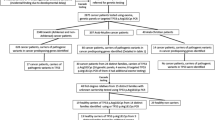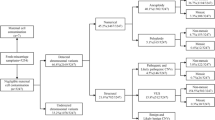Abstract
The mutation detection rate for familial cerebral cavernous malformations (CCM) is extremely high, being about 90 % if direct sequencing of the three genes, CCM1, CCM2, and CCM3, is used in conjunction with quantitative analyses to detect larger CCM1-3 deletions/duplications. We here report on an individual who had presented with more than 30 cerebral and spinal cavernous malformations, two intracranial meningiomas, and disease manifestation only in the mid-forties. A CCM1 missense variant of unclear relevance was found during the first sequencing step. Thereafter, direct sequencing of all three CCM genes revealed the typical pathogenic loss-of-function mutation c.598C > T/p.Q200* in the CCM3 gene. Our results demonstrate that mutation analyses of all three CCM genes in the index patient regardless of previous identification of an unclassified CCM1 variant is crucial for reliable predictive testing of at-risk relatives.

Similar content being viewed by others
References
Bergametti F, Denier C, Labauge P, Arnoult M, Boetto S, Clanet M, Coubes P, Echenne B, Ibrahim R, Irthum B, Jacquet G, Lonjon M, Moreau JJ, Neau JP, Parker F, Tremoulet M, Tournier-Lasserve E (2005) Mutations within the programmed cell death 10 gene cause cerebral cavernous malformations. Am J Hum Genet 76:42–51
Borry P, Stultiens L, Nys H, Cassiman J, Dierickx K (2006) Presymptomatic and predictive genetic testing in minors: a systematic review of guidelines and position papers. Clin Genet 70:374–381
Denier C, Labauge P, Bergametti F, Marchelli F, Riant F, Arnoult M, Maciazek J, Vicaut E, Brunereau L, Tournier-Lasserve E (2006) Genotype-phenotype correlations in cerebral cavernous malformations patients. Ann Neurol 60:550–556
Deutsche Gesellschaft für Humangenetik (GfH) (2011) S2-Leitlinie Humangenetische Diagnostik. Medgen 23:281–323
Felbor U, Sure U, Grimm T, Bertalanffy H (2006) Genetics of cerebral cavernous angioma. Zentralbl Neurochir 67:110–116
Gendiagnostik-Kommission (GEKO) (2011) Richtlinie der Gendiagnostik-Kommission (GEKO) zu genetischen Untersuchungen bei nicht-einwilligungsfähigen Personen nach § 14 in Verbindung mit § 23 Abs. 2 Nr. 1c GenDG. Bundesgesundheitsbl 54:1257–1261
Gianfrancesco F, Cannella M, Martino T, Maglione V, Esposito T, Innocenzi G, Vitale E, Liquori CL, Marchuk DA, Squitieri F (2007) Highly variable penetrance in subjects affected with cavernous cerebral angiomas (CCM) carrying novel CCM1 and CCM2 mutations. Am J Med Genet B Neuropsychiatr Genet 144:691–695
Gunel M, Awad IA, Finberg K, Anson JA, Steinberg GK, Batjer HH, Kopitnik TA, Morrison L, Giannotta SL, Nelson-Williams C, Lifton RP (1996) A founder mutation as a cause of cerebral cavernous malformation in Hispanic Americans. N Engl J Med 334:946–951
Kivelev J, Niemelä M, Hernesniemi J (2012) Treatment strategies in cavernomas of the brain and spine. J Clin Neurosci 19:491–497
Liquori CL, Berg MJ, Squitieri F, Ottenbacher M, Sorlie M, Leedom TP, Cannella M, Maglione V, Ptacek L, Johnson EW, Marchuk DA (2006) Low frequency of PDCD10 mutations in a panel of CCM3 probands: potential for a fourth CCM locus. Hum Mutat 27:118
Li X, Zhang R, Zhang H, He Y, Ji W, Min W, Boggon TJ (2010) Crystal structure of CCM3, a cerebral cavernous malformation protein critical for vascular integrity. J Biol Chem 285:24099–24107
Ng BHK, Mulyadi E, Pereira JK, Ghedia S, Pinner J, Mowat D, Vonau M (2006) Familial cerebral cavernous hemangioma diagnosed in an infant with a rapidly growing cerebral lesion. Australas Radiol 50:583–590
Riant F, Bergametti F, Ayrignac X, Boulday G, Tournier-Lasserve E (2010) Recent insights into cerebral cavernous malformations: the molecular genetics of CCM. FEBS J 277:1070–1075
Rigamonti D, Hadley MN, Drayer BP, Johnson PC, Hoenig-Rigamonti K, Knight JT, Spetzler RF (1988) Cerebral cavernous malformations. Incidence and familial occurrence. N Engl J Med 319:343–347
Siegel AM, Bertalanffy H, Dichgans JJ, Elger CE, Hopf H, Hopf N, Keidel M, Kleider A, Nowak G, Pfeiffer RA, Schramm J, Spuck S, Stefan H, Sure U, Baumann CR, Rouleau GA, Verlaan DJ, Andermann E, Andermann F (2005) Familiäre Kavernome des Zentralnervensystems. Eine klinische und genetische Studie an 15 deutschen Familien (Familial cavernous malformations of the central nervous system. A clinical and genetic study of 15 German families). Nervenarzt 76:175–180
Stahl S, Gaetzner S, Voss K, Brackertz B, Schleider E, Sürüçü O, Kunze E, Netzer C, Korenke C, Finckh U, Habek M, Poljakovic Z, Elbracht M, Rudnik-Schöneborn S, Bertalanffy H, Sure U, Felbor U (2008) Novel CCM1, CCM2, and CCM3 mutations in patients with cerebral cavernous malformations: in-frame deletion in CCM2 prevents formation of a CCM1/CCM2/CCM3 protein complex. Hum Mutat 29:709–717
Sürüçü O, Sure U, Gaetzner S, Stahl S, Benes L, Bertalanffy H, Felbor U (2006) Clinical impact of CCM mutation detection in familial cavernous angioma. Childs Nerv Syst 22:1461–1464
Voss K, Stahl S, Hogan BM, Reinders J, Schleider E, Schulte-Merker S, Felbor U (2009) Functional analyses of human and zebrafish 18-amino acid in-frame deletion pave the way for domain mapping of the cerebral cavernous malformation 3 protein. Hum Mutat 30:1003–1011
Zawistowski JS, Stalheim L, Uhlik MT, Abell AN, Ancrile BB, Johnson GL, Marchuk DA (2005) CCM1 and CCM2 protein interactions in cell signaling: implications for cerebral cavernous malformations pathogenesis. Hum Mol Genet 14:2521–2531
Acknowledgments
The authors thank the patient for her cooperation. Juliane Najm and Stefanie Spiegler are funded by EU grant EnVision (FP7-REGPOT-2010-1, Grant no. 264143).
Author information
Authors and Affiliations
Corresponding author
Additional information
Comments
Juri Kivelev, Helsinki, Finland
The amount of incidental CM cases has been increased gradually throughout the world. There is no doubt about the reasons of this phenomenon: the availability of neuroimaging tools is getting better all the time. In such environment, we are transferring more and more towards prophylactic medicine, which, however, imposes new demands on practitioners' everyday clinical work.
In terms of population screening and prophylactic treatment, the work of Schröder et al. is very important, since the authors emphasize the complexity of decision making process when dealing with familial CMs. Most of these patents are prone to have multiple lesions with significant risk of de novo CM formation. Thus, a prophylactic surgery in such cases might be very controversial. This was also shown in our previous investigations (1), where the long-term outcome in operated and conservatively-treated patients with multiple CMs occurred to be the same.
These findings confirm the need of new noninvasive reliable diagnostic tools, which may predict the clinical course of CM. Genetic screening is definitely the future of medicine; and with widespread availability of simple laboratory testing, the financial aspects are not anymore limiting its use in daily practice.
But the ethical aspects do.
Is it worth to check the presence of some particular CCM mutation in asymptomatic children? Is it reasonable to impose such a severe psychological pressure on CM patients with familial history, while the risks of clinical manifestations are quite low, and, even when occur, the symptoms are rarely invaliding? These questions are appropriately highlighted in the report of Schröder et al. Furthermore, authors accurately discussed very important practical issue: the attitude of the insurance companies and employers to the fact of pathological gene confirmation in clinically unaffected patients what might affect significantly the patients' personal life in the future.
In congruence with authors, we think that a decision to perform genetic screening in families affected by CM should be very studious; delicateness, logicality, and patience are key factors of effective cooperation.
References
1 Kivelev J, Niemelä M, Kivisaari R, Dashti R, Laakso A, Hernesniemi J. Long-term outcome of patients with multiple cerebral cavernous malformations. Neurosurgery 65(3):450–455, 2009
Felix Rosenow, Karl Martin Klein, Marburg, Germany
Schröder et al. report an illustrative case with familial cavernous malformations. During sequence analysis of the gene CCM1, a missense variant of unclear relevance was found. The authors continue to sequence CCM2 and CCM3 and identify a clearly pathogenic truncation mutation in CCM3. This case nicely illustrates that not every sequence change is a pathogenic mutation and careful consideration of each variant and possibly sequencing of additional genes is necessary to identify the causative mutation. This is of paramount importance for predictive genetic testing of at-risk relatives.
Rights and permissions
About this article
Cite this article
Schröder, W., Najm, J., Spiegler, S. et al. Predictive genetic testing of at-risk relatives requires analysis of all CCM genes after identification of an unclassified CCM1 variant in an individual affected with cerebral cavernous malformations. Neurosurg Rev 37, 161–165 (2014). https://doi.org/10.1007/s10143-013-0478-6
Received:
Revised:
Accepted:
Published:
Issue Date:
DOI: https://doi.org/10.1007/s10143-013-0478-6




